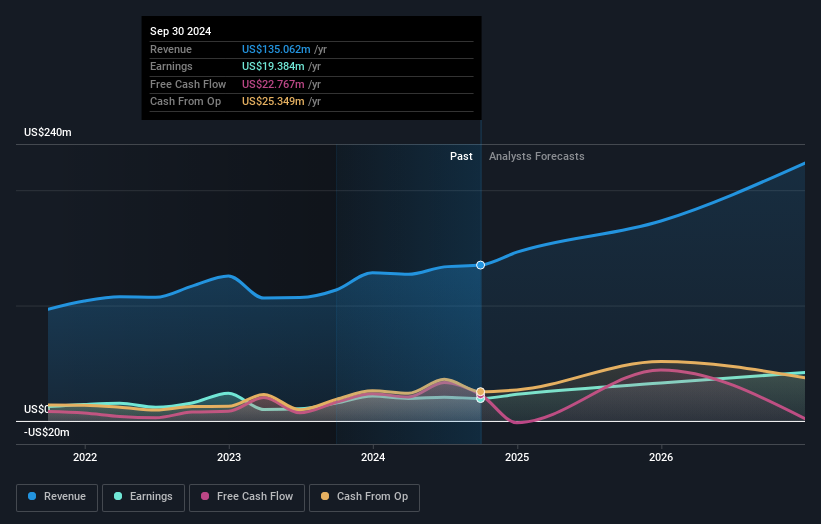- United States
- /
- Machinery
- /
- NasdaqGS:ERII
Institutional owners may consider drastic measures as Energy Recovery, Inc.'s (NASDAQ:ERII) recent US$56m drop adds to long-term losses

Key Insights
- Institutions' substantial holdings in Energy Recovery implies that they have significant influence over the company's share price
- The top 12 shareholders own 51% of the company
- Recent sales by insiders
If you want to know who really controls Energy Recovery, Inc. (NASDAQ:ERII), then you'll have to look at the makeup of its share registry. We can see that institutions own the lion's share in the company with 87% ownership. That is, the group stands to benefit the most if the stock rises (or lose the most if there is a downturn).
And institutional investors saw their holdings value drop by 4.9% last week. This set of investors may especially be concerned about the current loss, which adds to a one-year loss of 3.5% for shareholders. Also referred to as "smart money", institutions have a lot of sway over how a stock's price moves. As a result, if the downtrend continues, institutions may face pressures to sell Energy Recovery, which might have negative implications on individual investors.
Let's take a closer look to see what the different types of shareholders can tell us about Energy Recovery.
View our latest analysis for Energy Recovery

What Does The Institutional Ownership Tell Us About Energy Recovery?
Many institutions measure their performance against an index that approximates the local market. So they usually pay more attention to companies that are included in major indices.
As you can see, institutional investors have a fair amount of stake in Energy Recovery. This suggests some credibility amongst professional investors. But we can't rely on that fact alone since institutions make bad investments sometimes, just like everyone does. If multiple institutions change their view on a stock at the same time, you could see the share price drop fast. It's therefore worth looking at Energy Recovery's earnings history below. Of course, the future is what really matters.

Investors should note that institutions actually own more than half the company, so they can collectively wield significant power. Hedge funds don't have many shares in Energy Recovery. Looking at our data, we can see that the largest shareholder is BlackRock, Inc. with 8.9% of shares outstanding. Columbia Management Investment Advisers, LLC is the second largest shareholder owning 6.9% of common stock, and Brown Capital Management, LLC holds about 6.1% of the company stock.
Looking at the shareholder registry, we can see that 51% of the ownership is controlled by the top 12 shareholders, meaning that no single shareholder has a majority interest in the ownership.
While it makes sense to study institutional ownership data for a company, it also makes sense to study analyst sentiments to know which way the wind is blowing. There are plenty of analysts covering the stock, so it might be worth seeing what they are forecasting, too.
Insider Ownership Of Energy Recovery
While the precise definition of an insider can be subjective, almost everyone considers board members to be insiders. Management ultimately answers to the board. However, it is not uncommon for managers to be executive board members, especially if they are a founder or the CEO.
I generally consider insider ownership to be a good thing. However, on some occasions it makes it more difficult for other shareholders to hold the board accountable for decisions.
Our most recent data indicates that insiders own some shares in Energy Recovery, Inc.. It is a pretty big company, so it is generally a positive to see some potentially meaningful alignment. In this case, they own around US$26m worth of shares (at current prices). It is good to see this level of investment by insiders. You can check here to see if those insiders have been buying recently.
General Public Ownership
With a 11% ownership, the general public, mostly comprising of individual investors, have some degree of sway over Energy Recovery. While this size of ownership may not be enough to sway a policy decision in their favour, they can still make a collective impact on company policies.
Next Steps:
It's always worth thinking about the different groups who own shares in a company. But to understand Energy Recovery better, we need to consider many other factors. To that end, you should be aware of the 2 warning signs we've spotted with Energy Recovery .
If you are like me, you may want to think about whether this company will grow or shrink. Luckily, you can check this free report showing analyst forecasts for its future.
NB: Figures in this article are calculated using data from the last twelve months, which refer to the 12-month period ending on the last date of the month the financial statement is dated. This may not be consistent with full year annual report figures.
Valuation is complex, but we're here to simplify it.
Discover if Energy Recovery might be undervalued or overvalued with our detailed analysis, featuring fair value estimates, potential risks, dividends, insider trades, and its financial condition.
Access Free AnalysisHave feedback on this article? Concerned about the content? Get in touch with us directly. Alternatively, email editorial-team (at) simplywallst.com.
This article by Simply Wall St is general in nature. We provide commentary based on historical data and analyst forecasts only using an unbiased methodology and our articles are not intended to be financial advice. It does not constitute a recommendation to buy or sell any stock, and does not take account of your objectives, or your financial situation. We aim to bring you long-term focused analysis driven by fundamental data. Note that our analysis may not factor in the latest price-sensitive company announcements or qualitative material. Simply Wall St has no position in any stocks mentioned.
About NasdaqGS:ERII
Energy Recovery
Designs, manufactures, and sells energy efficiency technology solutions in the Americas, the Middle East, Africa, Asia, and Europe.
Flawless balance sheet with solid track record.


